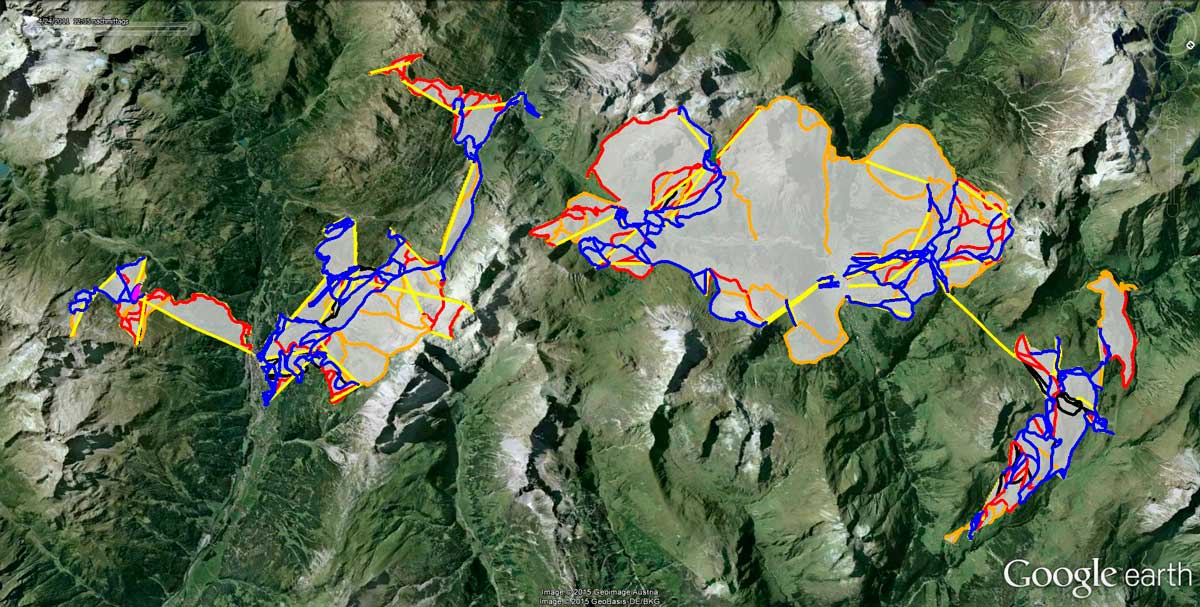Size of the skiing area
Studies have shown that for the vast majority of snow sports enthusiasts, the size of a ski area is the most important factor when choosing their destination for a ski or snowboard holiday. This is reflected in a number of polls. For the day visitor, the size of the ski area and variety of slopes are important as well, as indicated by the result of a survey by the Association of Austrian cable car operators.
But how does one establish the size of a ski area? Most European skiers would regard this as the sum of the length of all downhill runs. But there are other parameters for establishing the size of a ski area:
This is the most important parameter in north American resorts. It includes groomed pistes and marked/secured off-piste skiing. The width of the run is also taken into consideration. A run of 1,000 m length by 200 m width (20 hectares) is evidently larger than a catwalk of 4 km in length by 5 m in width (2 hectares).
While the number of runs plays a minor part in Europe, almost everywhere else it is a major factor when advertising a ski area, particularly in east American resorts. For advertising purposes, it is common that runs are divided into different segments (upper, middle, lower) to establish a larger number.
The most important parameter world wide! However, there are big differences – a magic carpet of 8m can’t be compared with a shuttle train connecting numerous mountain flanks and dozens of piste kilometers. Some resorts include magic carpets and T-bar lifts in this number, others do not.
The capacity of the lift system in skiers per hour is commonly published as well but not really for advertising purposes. Almost exclusively in North America, the information includes the VTM/VTF (vertical transport capacity in meters/feet). This provides a clearer indication of the capacity as it also includes the vertical drop of each lift. A magic carpet might transport up to 1,400 people in an hour but only a few meters up. A cable car transporting the same number of people to a spot 500 meters above its starting point is more significant. For the visitor however, this figure is irrelevant as it only gives an indication for waiting times or piste overcrowding, contributing to comfort and quality, if it set into relatioon to the number of skiers and boarders in the ski area.
Some resorts do not provide the skiable area accessible but the overall boundary area. A large-scale resort with a small network of slopes would thus beat a resort with a large network of slopes but smaller in size. It would stretch across a number of mountains each accessible by one or two lifts whereas in smaller resorts numerous parallel slopes are running down the side of a single mountain face. So the physical extent of the area influences the perception of the size of the skiing area. The correct area size is established by drawing a polygon around the digitized slopes and lifts at their outer border and measuring the total area within. The skiing area therefore is the area one can not leave without crossing a slope or a lift. This is illustrated below (skiing areas at Arlberg):

This is another important parameter in North America resorts but hardly plays a role in Europe although it is an indicator for perceived size. The diversity of the landscape influences the perception of size. Ski areas reaching up from vineyards along coniferous and deciduous woodlands up to a glacier appear large even if the total length of runs is not.
The number of visitor days in a ski area is a key parameter for the success of the resort and its market share. It is of secondary significance to the visitors but can be used to derive the relation between visitation level and available terrain. In a resort with 150 kms of runs and 300,000 skier visits, the runs are less crowded than in a resort of the same size but with 1.5 mio visitors per season - and yes, such differences exist.
The landscape character can also influence the perceived size of the resort. A resort on a single mountain flank looks smaller than one incorporating various mountains, valleys and peaks even if the total length of the runs is the same.
We are currently working on establishing a key parameter for measuring the actual size of a ski area including relevant criteria on the basis of their importance. Every skier will have his/her own priority. A survey is being conducted to establish these priorities – please click to be included (the survey is only partly available in English language).
Contact

Montenius Consult
Christoph Schrahe
Diesterwegstraße 29
51109 Köln
Phone.: +49 221 94653533
Fax: +49 221 94653534
Mobile: +49 177 8340052
Email: schrahe [at] montenius.com


